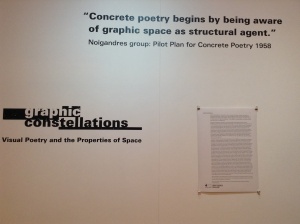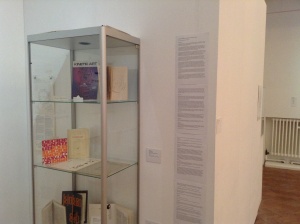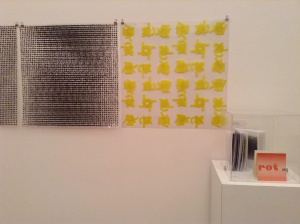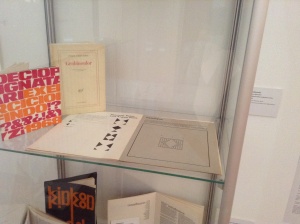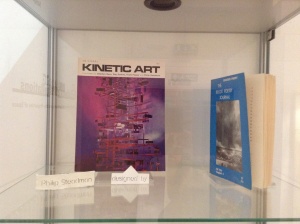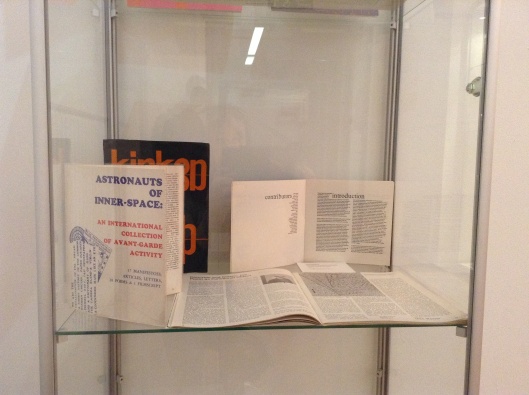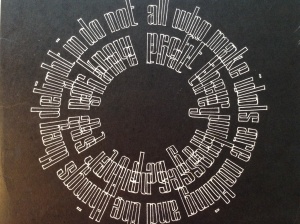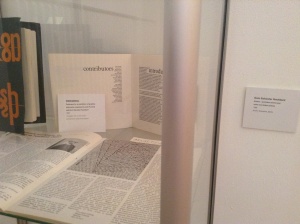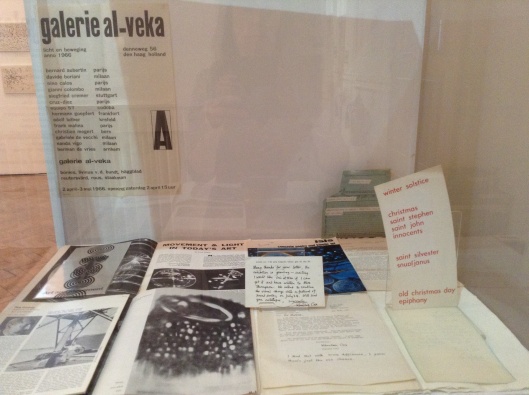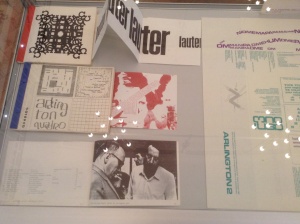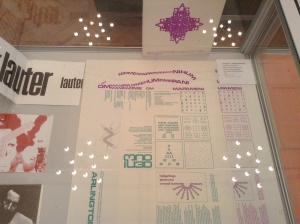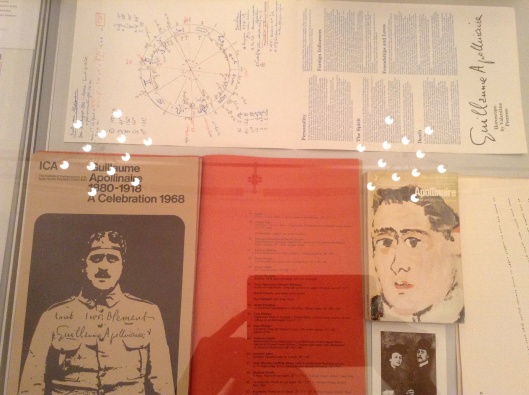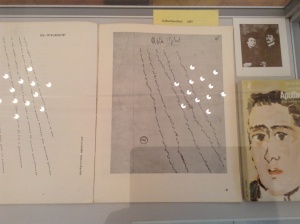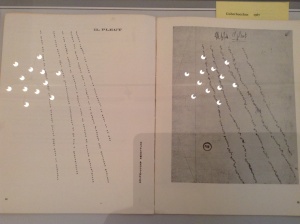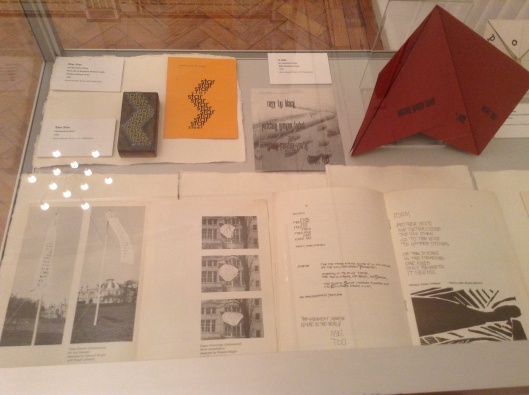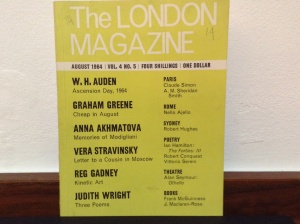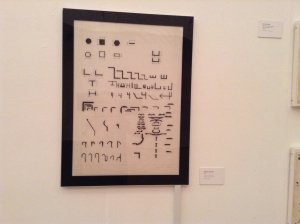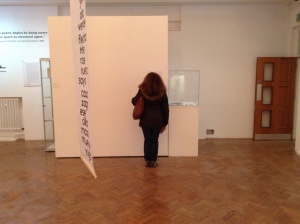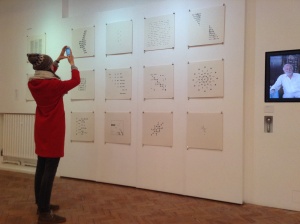Graphic Constellations – Visual Poetry & the Properties of Space
An outline of Materials on floor display
Vitrine One
Materials in this vitrine are closely connected to the first international exhibition of concrete, kinetic and phonic poetry held at St. Catharine’s College in 1964 and its relationship to design as well as antecedent and core figures/texts.
The admirable graphic design work of Philip Steadman co-organiser of the 1st exhibition and designer of Form and Image 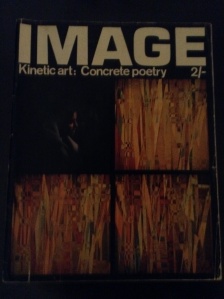 magazines as well as several other significant publications including KINETIC ART (1966: eds Stephen Bann, Reg Gadney, Frank Popper, Philip Steadman; Motion Books) and the Beloit Poetry Journal (edited by Stephen Bann, 1966) open at pages 24-25, showing works by Pierre Garnier, is highlighted on upper shelf.
magazines as well as several other significant publications including KINETIC ART (1966: eds Stephen Bann, Reg Gadney, Frank Popper, Philip Steadman; Motion Books) and the Beloit Poetry Journal (edited by Stephen Bann, 1966) open at pages 24-25, showing works by Pierre Garnier, is highlighted on upper shelf.
Below can be seen Granta magazine published in Cambridge in November 1964 which had the catalogue for the St. Catharine’s exhibition as insert with an accompanying statement about the interrelationship of design and poetry by Decio Pignatari, a founding member of the Noigandres group in Brazil who was also an industrial/graphic designer. Pignatari’s Exercicio Findo poetry collection (1968) is also shown here courtesy of Archiv Acquaviva, Berlin.
To the left is Pierre Albert-Birot’s Grabinoulor (Gallimard, 1964) included in the original 1964 exhibition, also on loan from Archiv Acquaviva. Birot was a friend of Guillaume Apollinaire whose birth chart drawn up and designed by Valentine Penrose as part of the Institute of Contemporary Arts in London’s 1968 Celebration of the 50th Anniversary of Apollinaire’s death be seen if you look left of the vitrine.
On the third shelf is a copy of Image magazine 1964 themed Kinetic art Concrete poetry designed by Steadman featuring an essay by Mike Weaver on concrete and kinetic poetic cross-currents. Weaver was primary catalyst behind the first international exhibition setting up connections with poets across the world as is referenced in texts by Decio Pignatari and Dom Sylvester Houedard in the Astronauts of Inner-Space, an International Anthology of Avant-Garde Activity, Stolen Paper Review Editions; edited by Jeff Berner, 1966 which reproduced some material found in the visionary Times Literary Supplement of September 1964 edited by John Willett.
Houedard’s Kinkon: op kinkon poems/and some non kinkon collection is found alongside here on loan also from Archiv Acquaviva. The word Kinkon was dsh’s characteristically inventive conjunction of Kinetic and Concrete which he applied liberally and particularly to reference the exhibition at St Catharine’s which he writes about at more length in the copy of Isis (found in Vitrine Two).
Beside this is a copy of the 1967 catalogue for the Freewheel exhibition of graphic design and concrete poetry which toured in June that year to the then Arts Council Gallery in Cambridge having been generated by John Furnival and dsh (who provides an inspiring foreword (“…if graphic bred concrete”..) and involving students from Corsham (now Bath) Academy of Art and Watford School of Art in collaboration with poetic luminaries including Ian Hamilton Finlay. The Freewheel loan is courtesy of Ann Noel.
On the bottom shelf can be found the Gaberbocchus Press copy of Raoul Haussman and Kurt Schwitters collaborative text PIN published in 1962 edited by Jasia Reichardt which was also on display in the original 1964 exhibition. This is accompanied by a copy of Form from 1967 designed by Philip Steadman with a text by Haussman (courtesy of Steadman) and a very rare copy of Henri Chopin’s L’Armoire published in Sao Paulo by Praxis in 1964, shown courtesy of Archiv Acquaviva, Berlin.
Vitrine Two
Materials relating to the work of Frank J. Malina are contained in this vitrine, shown courtesy of the Malina family. The issue of Isis on the concrete kinetic theme has writing by dsh, Stephen Bann and others as well as a colourful feature on Malina’s then recently installed mural within the former HQ of the Pergamon Press in Oxford, now part of Oxford Brookes University where the mural remains but is now concealed.
The material also includes an early article by Frank Popper from the Unesco Courier 1963 on Movement and Light in Today’s Art which can be downloaded at http://unesdoc.unesco.org/images/0007/000783/078356eo.pdf and an invitation to the Art and Movement Exhibition funded by ACGB in 1965-1966 which toured to Edinburgh, Glasgow, Belgium and Israel. Paul Keeler, co-founder of Signals Gallery in London which was a bright flare on the constructivist/kinetic horizon from 1964-1966, was an advisor for this impressively futuristic exhibition which included three Malina works. A letter from Keeler from January 1965 to Malina about showing his work at Signals later that year is shown with a telegram sent by Signals artist David Medalla and Paul Keeler to ‘Colonel Malina’ congratulating him on a ‘Moon Crash’.
Rather touching correspondence with Kenelm Cox about bringing Malina’s Oui et Non work to the 1966 Arlington Festival, including a beautiful Christmas card sent by Cox to Malina and a copy of Malina’s letter to Cox from 31.12.66 is also on show.
Vitrine Three
This vitrine contains promotional materials from two exhibitions of his kinetic paintings which Malina had in Paris in the 1960s alongside a publication called revue Integration, no 4, November 1965. Styled as a ‘review for a new conception in art and culture’ by its creator and editor Herman de Vries (who may also have been responsible for hand-typing it) this issue reproduced material from the Image Concrete Kinetic issue written by Malina and Steadman.
Vitrine Four
This has catalogue from Hansjorg Mayer’s major exhibition at the Hague in 1968 which was designed in collaboration with Ann Noel and has kindly been loaned by Mayer.
Vitrine Five
Material in this vitrine:
‘Evening will Come, they will sew the blue sail’ catalogue/book edited and designed by Graeme Murray; published on the occasion of the Fruitmarket Gallery, Edinburgh, Exhibition 1991: ‘Ian Hamilton Finlay and The Wild Hawthorn Press 1958-1991’. Open at page 21:
Ajar, screenprint 1967.
Poor Old Tired Horse no 12. Concrete issue. Wild Hawthorn Press, Scotland.
Poor Old Tired Horse, Brighton Festival of Concrete Poetry issue. Wild Hawthorn Press, Scotland.
Epok anno ’66: lichten beweging. konkrete poezie festival brochure (courtesy Malina family archive).
Image magazine: Spring/Summer 1966 issue. Article by Stephen Bann on Kinetic Art and Poetry. Loan courtesy of Stephen Bann.
MONAD Issue 1: Chelsea School of Art, Summer 1964. Feature on Groupe de Recherche d’Art Visuel. Open at New Directions text & Hyphens work by Francois Morellet (1961).
Vitrine Six
The Arlington Festivals of the mid-1960s brought remarkable gatherings of people and works to a Mill in deep rural Gloucestershire. The Festival developed through its links to Corsham Academy of Art and its inspirational array of tutors/visiting lecturers including Ken Cox, John Furnival, dsh, Jasia Reichardt and Hansjorg Mayer and the catalogues (shown here with gorgeous foldout inserts by Ernst Jandl and John Sharkey among others) are now highly prized representing the width and breadth of what we now think of as concrete poetry with kinetic and phonic elements.
The introductions to the catalogues written by dsh provide invaluable insight into the cross-currents and movements of ideas regionally, nationally and internationally, among poets working in experimental ways at that time. Photographs of the exhibitions reveal inclusive and crowded display tendencies which has mostly been ironed out by contemporary curators of text-orientated shows today. Graphic Constellations pays tribute to the Arlington festivals as temporary constellations of radical text.
Vitrine Seven
This vitrine notes the influence of Guillaume Apollinaire on practitioners of concrete, kinetic, phonic and visual poetry in the 1960s. The ICA staged a major show curated by Simon Watson Taylor who refers in his catalogue introduction to:
“the synthesis of the graphic and the visual space as the new framework for creative endeavour”.
There were several elements to the catalogue, designed by James Mellor and Anthony McCall. We are showing a tiny fraction here of relevant works as can be seen by the list of artists and works named which include Liliane Lijn, Emmett Williams, Paul de Vree, Bob Cobbing, Alan Riddell and many others for whom Apollinaire was and is an enduring influence. Anthony Scott presented a work called Rose-tinted Flying Fragmented Concrete/Kinetic Poetry Space Room Spectacle. John Furnival and Henri Chopin collaborated on a sound poem on tape called Eleven Hundred and Eleven, a mixed media environment for concrete poem. Lijn showed for the first time her Poemkon=D=4=Open=Apollinaire 1968 work which is now visible on the Ruskin Gallery large digital screen.
On display is Picasso’s 1907 postcard to Apollinaire where he addresses him as ‘Senor Don Guillaume Apollinaire’ and depicts him as Don Quixote reproduced from a photograph of the original held in Apollinaire’s estate.
The photograph is of Guillaume Apollinaire and Annie Playden in London in 1904.
On display bottom right are two pages of catalogue preface to the Irene Lagut/Leopold Survage Exhibition, Paris, 1917.
We are showing also the Stefan Themerson/Gaberbocchus Press publication: Apollinaire’s Lyrical Ideograms (1968) open at Pages 24 and 25 which is a copy of Apollinaire’s original drawing/writing of Il Pleut.
Francis Steegmuller’s 1963 Pelican Biography: Apollinaire Poet among the painters is also included.
Vitrine 8: works by Hansjorg Mayer – as per labels.
Edward Wright vitrine: materials as labelled courtesy of Anna Yandell and Ann Pillar
Vitrine Nine
In this bookcase are poetry books mainly from the 1960s and two copies of London Magazine from 1964 and 1965 featuring articles on kinetic art by Reg Gadney, both courtesy of the Malina family archive.
The cover of the Poems of the Sixties book is by Bridget Riley.
Takis designed the cover of The Green Tunnel, a rare Signals Gallery poetry publication.
Alan Riddell’s Eclipse (Calder & Boyars) contains many beautiful concrete/typewriter works from the 1960s reflecting his deep engagement with moon landings, planetary explorations and celestial adventures including his Apollo series. Loan courtesy of Jonathan Ross.
The stencil set was owned by Mr E.G. Ferran a keen calligrapher and careful hoarder of materials for use by future generations.
Graphic Constellations: Visual Poetry & the Properties of Space has been generously supported by Anglia Ruskin University, Arts Council of England Grants for the Arts, Cambridge School of Art and all the artists and archives which have loaned work. We would like to sincerely thank Anna Yandell, Hansjorg Mayer, Ann Noel, Liliane Lijn, Ann Pillar, the Malina Family, Archiv Acquaviva Berlin, Jon Pratty, Stephen Bann, Reg Gadney, Philip Steadman, Mike Weaver for their kind support and encouragement and the Alison Richard Building & Kettle’s Yard for loan of additional vitrines which have made this show possible.

